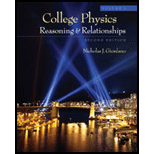
Concept explainers
(a)
The acceleration due to gravity at a height
(a)
Answer to Problem 71P
The acceleration due to gravity is
Explanation of Solution
The gravitational force of an object on the Earth’s surface is determined by Newton’s universal law of gravitation. Which is given by,
Here,
Force of gravity is the only force acting on the station so that for an object in orbit it must be providing the entire centripetal acceleration,
The acceleration of the station when it is moving in a circle must be centripetal acceleration which is given by,
The expression for the time period is given by,
Conclusion:
The orbit of the station is equal to Earths radius plus height above the surface so that,
Substitute
Substitute
Substitute
Therefore, The acceleration due to gravity is
(b)
The orbital velocity and period of the telescope.
(b)
Answer to Problem 71P
The orbital velocity is
Explanation of Solution
Substitute
Conclusion:
Substitute
Therefore, The orbital velocity is
Want to see more full solutions like this?
Chapter 5 Solutions
COLLEGE PHYSICS,VOL.1
- A capacitor with a capacitance of C = 5.95×10−5 F is charged by connecting it to a 12.5 −V battery. The capacitor is then disconnected from the battery and connected across an inductor with an inductance of L = 1.55 H . At the time 2.35×10−2 s after the connection to the inductor is made, what is the current in the inductor? At that time, how much electrical energy is stored in the inductor?arrow_forwardCan someone help me with this question. Thanks.arrow_forwardCan someone help me with this question. Thanks.arrow_forward
 Principles of Physics: A Calculus-Based TextPhysicsISBN:9781133104261Author:Raymond A. Serway, John W. JewettPublisher:Cengage Learning
Principles of Physics: A Calculus-Based TextPhysicsISBN:9781133104261Author:Raymond A. Serway, John W. JewettPublisher:Cengage Learning Classical Dynamics of Particles and SystemsPhysicsISBN:9780534408961Author:Stephen T. Thornton, Jerry B. MarionPublisher:Cengage Learning
Classical Dynamics of Particles and SystemsPhysicsISBN:9780534408961Author:Stephen T. Thornton, Jerry B. MarionPublisher:Cengage Learning University Physics Volume 1PhysicsISBN:9781938168277Author:William Moebs, Samuel J. Ling, Jeff SannyPublisher:OpenStax - Rice University
University Physics Volume 1PhysicsISBN:9781938168277Author:William Moebs, Samuel J. Ling, Jeff SannyPublisher:OpenStax - Rice University
 Stars and GalaxiesPhysicsISBN:9781305120785Author:Michael A. Seeds, Dana BackmanPublisher:Cengage Learning
Stars and GalaxiesPhysicsISBN:9781305120785Author:Michael A. Seeds, Dana BackmanPublisher:Cengage Learning Glencoe Physics: Principles and Problems, Student...PhysicsISBN:9780078807213Author:Paul W. ZitzewitzPublisher:Glencoe/McGraw-Hill
Glencoe Physics: Principles and Problems, Student...PhysicsISBN:9780078807213Author:Paul W. ZitzewitzPublisher:Glencoe/McGraw-Hill





